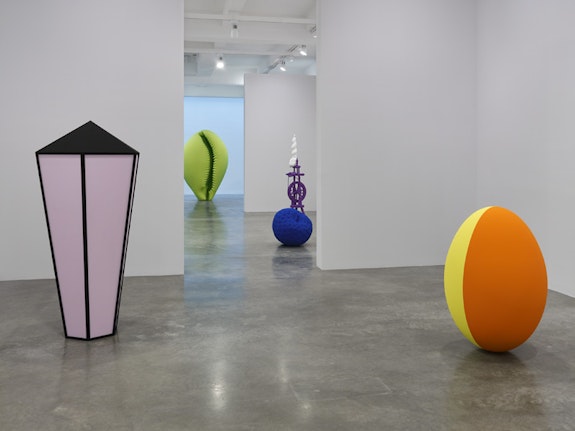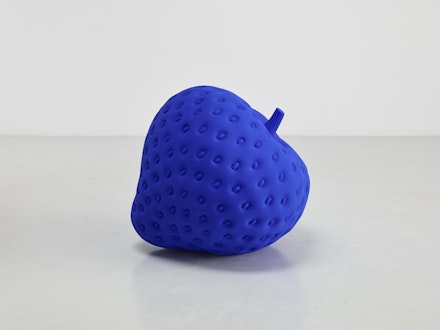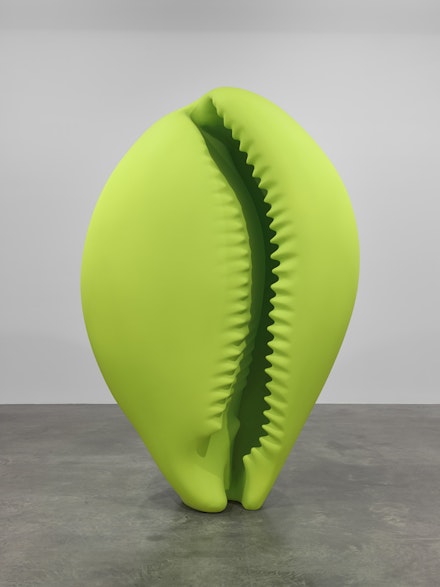ArtSeen
KATHARINA FRITSCH
On View
Matthew MarksNovember 4 – December 22, 2017
New York
How big is a cotton spinning wheel supposed to be? That was the question that bothered me most walking out of Katharina Fritsch’s recent exhibition at Matthew Marks. Most of the seven sculptures she made for the show were obviously outsize editions of all sorts of things, like a giant blue strawberry titled Erdbeere/Strawberry from 2017 that looked like an ottoman proposed by a Memphis group designer, and a bronze, painted, neon green seashell (Muschel [Hellgrün]/Shell [Light Green] from 2015) that loomed more than nine feet tall. But Fritsch’s purple spinning wheel (Spinnrad/Spinning Wheel from 2017)—rendered in fine detail, just like an antique would be, and topped off with what looked like a drooping heap of lush, white cotton (in fact, the entire sculpture is made of epoxy and polyester)—was practically impossible to scale. It may have been a little bigger than an actual spinning wheel; it may have been a little smaller too. Or maybe it was built exactly to size. Without a direct comparison, it was impossible to say.
Fritsch is especially good in this defamiliarizing register. She has long excelled at taking things we think we know—umbrellas, apples, rodents, statuary figures—and twisting them through scale and color into alien objects. The best works at Matthew Marks did that as well as ever. The green seashell (which was given its own gallery) was so neatly painted that from behind, the top of it looked like a completely flat, floating disc—until you looked down and saw its shadow cut across the gallery floor. The same was true of a four-foot-tall plastic egg (Ei/Egge from 2017) that Fritsch painted half orange and half yellow. From certain angles, with only the orange half visible, the sculpture looked like a bright, flat, hovering apparition.
Earlier in her career, Fritsch was keener to upset her audience emotionally. Works like Kind mit Pudeln/Child with Poodles (1995-96), where 224 black dogs in four concentric circles surround an infant, carried a violent charge that’s largely absent in the recent work (even if the skull at the front of the Matthew Marks gallery, titled Schädel/Skull from 2017, was a memento mori). These days, she is more interested in the many contradictory associations a sculpture can trigger. Fritsch’s Hahn/Cock (2010–13), the handsome, giant blue rooster she showed on the Fourth Plinth in Trafalgar Square in London (now on long-term loan to the National Gallery of Art in Washington, DC), is at once a criticism of heroic masculinity and a show of strength. Similarly, a sculpture of a lantern shown at Matthew Marks (Laterne/Lantern from 2017) was simultaneously a reminder and a rebuttal of Enlightenment ideals, just as the spinning wheel recalls the horrors of slavery as much as it does the quaintness of pre-industrial life.
These associations make Fritsch’s sculptures incredibly adaptable; they could fit into any number of themed group exhibitions (A clever curator, for example, could put many of her works alongside Rona Pondick’s ghastly and brilliant sculptures of dogs with men’s heads). But whereas most group shows flatten an artist’s work to serve a specific curatorial purpose, the advantage and risk of a solo exhibition is that the work stands or falls on its own accord. Fritsch, as ever, emerges from the Matthew Marks exhibition (her first in New York since 2008) in a strong position. Her sculptures play well off one another, and seeing them together (even only seven of them) deepens their strangeness.
So where does she go from here? The antiquated cotton spinning wheel, which is already so unfamiliar, may point in a new direction. For much of her career, Fritsch has dug deep into the kind of work we are familiar with, consistently surprising us with the flexibility of her relatively limited stylistic range. It seems she can obscure and enlighten any everyday thing. But the spinning wheel is not an everyday thing; we rarely encounter one anymore. It comes to us as an already alien device, a technological relic few of us understand. What more can Fritsch do in this territory, where she takes as her subject things we do not know? Perhaps it’s a question for her next body of work.




